
Three directions for the next phase in the life of Kibo
— Research onboard Kibo is entering a new phase. Could you explain how things are going to change?
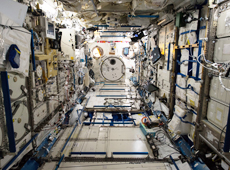 Inside Kibo’s Pressurized Module (courtesy of JAXA/NASA)
Inside Kibo’s Pressurized Module (courtesy of JAXA/NASA)
Japan’s first human space facility, Kibo, was completed in July 2009. We have since conducted many different experiments there, in the microgravity environment of space. At first we were groping for how best to put the experiment module to use, but over time we came to a better understanding of which fields could benefit the most from experiments in the space environment, and how to perform these experiments to ensure they would go smoothly. Based on the experience we have gained, we are now planning to move on to the next phase in the utilization of Kibo. We will concentrate on experiments from which we can expect great contributions to society.
We are currently focusing on three directions. One is to contribute directly to Japan’s national science and technology strategy. We plan to use Kibo to help implement the country’s strategic research agenda, which includes genomic medicine, regenerative medicine, and energy conservation.
The second is to contribute to the research agenda of private companies. We will use Kibo to help with pharmaceutical research and with the development of new materials, in order to enhance the competitiveness of Japanese industry.
The third is to develop technology that will be key to Japanese space exploration in the future. International collaboration on lunar and Mars exploration programs in now under discussion. Japan needs to acquire technology that will allow it to play many roles in such programs, and we will use Kibo as a platform for testing this new technology.
So we are working on broadening the opportunities for experiments on Kibo, enabling more challenging experiments, and enhancing the diversity of research fields by employing new and innovative ideas.
— How do you decide which experiments to do?
We like experiments that have a clear practical potential: helping solve a specific problem, or improving the performance of a certain technology or product.
So last year we invited potential users in Japan to submit ideas for experiments on Kibo. In the category of research that benefits the national technology strategy, we chose two fields: epigenomics related to human disease, and regenerative medicine, such as 3D organ culture. And in addition, we said we are open to innovative research ideas in any field.
Before starting preparations for these experiments in space, we invited all the participants to compete for some funding to cover the cost of preliminary experiments on the ground and analysis of the results. During that preliminary process, the significance and application of the research is being assessed by JAXA and other an advisory committee.
In addition, we have a paid utilization program, mainly targeting private-sector companies in Japan. Users cover the cost of their experiment, and they own the outcomes, including the intellectual property. When a user agrees to pay, we see it as a sign that they are optimistic about the research and the potential return. In other words, those who apply to conduct a paid experiment on Kibo have a clear vision about the practical application of their research.
One of my jobs is to increase the number of such corporate users. To promote Kibo utilization among corporations, we are working with the Japan Science and Technology Agency to introduce Kibo at events held for business leaders. We do our best to ensure that those who are interested in experiments on Kibo can achieve their goal.
As easy as possible and as fast as possible
— What kind of experiments tend to yield good results in space?
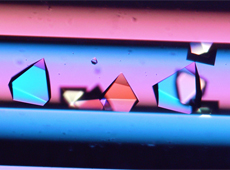 Space-grown protein crystals
Space-grown protein crystals
It’s hard to generalize, but for example, hopes for new cancer drugs are growing based on the results of the protein crystal growth experiment. To put it simply, cancer is triggered when specific proteins in your body activate. If we can analyze the structure of the protein in detail, we may be able to identify which part of the protein is involved in triggering the disease. And if we can then find a chemical compound that prevents that trigger, that can lead to the creation of an effective drug. But for this to happen, you need high-quality crystals of the proteins that act as disease triggers. The challenge is that it is difficult to grow good crystals on the ground because of convection due to the influence of gravity. It is possible in space, though, as there is no gravity.
We have tried growing various kinds of protein crystals on Kibo. Based on that experience, we are finding that crystallization in space requires some preparation prior to launch, including enhancing the purity of the protein and setting the right conditions for crystallization. We’ve discovered that doing this can increase the chances of success, even for proteins that have previously failed in crystallization.
With what we have learned, we have started developing technology to achieve crystallization at low temperatures and to grow crystals of membrane proteins, which are known to be particularly difficult. Membrane proteins are proteins usually seen on cell membranes, and have a lot to do with the activity of living organisms. So crystal growth experiments on Kibo have entered the next phase.
The protein crystal growth experiment is one of the first of the standardized services we have been working on offering. We determine the best conditions for a user’s protein sample to form crystals, and send the sample to the ISS. After the experiment, the sample is brought back to the ground and returned to the user with X-ray structure analysis. Such a sequence of services is offered as a standard package.
— In the standardized services, is the preparation time for an experiment shortened?
In the case of a protein crystal growth experiment, it’s about 10 months from the receipt of a sample to its return to the user. We hope to shorten that cycle further still, but it is still much faster than custom-made experiments. For example, let’s say there is an idea for an experiment. If you design a new experimental method and a new instrument, it takes several years before you can conduct the experiment. You can imagine that some corporations would be hesitant to wait that long from idea to implementation. But our standardized services can resolve this problem by simplifying the procedure and shortening the wait times. The fee for a protein crystal growth experiment is 1.7 million Yen (about 15,000 USD) per sample, and we are receiving favorable feedback about the pricing from users. To further promote Kibo utilization, I think it’s important to offer a competitive price.
Working with users from concept onwards
— Are there more standardized services that you offer?
 Deployment of small satellites (courtesy of JAXA/NASA)
Deployment of small satellites (courtesy of JAXA/NASA)
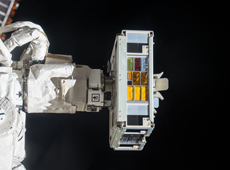 ExHAM installed in Kibo’s Exposed Facility (courtesy of JAXA/NASA)
ExHAM installed in Kibo’s Exposed Facility (courtesy of JAXA/NASA)
We provide a service for releasing small satellites from Kibo. And last year, we also started an experiment using the Exposed Experiment Handrail Attachment Mechanism (ExHAM). In this experiment, a user’s sample is placed on the ExHAM, attached to the outside of Kibo, and is exposed to outer space for up to two years. The goals of these experiments vary from testing the endurance of materials used in space, such as insulation for a satellite, to catching space debris to look for organic matter and microorganisms.
Conventionally, experiments done outside a spacecraft require astronauts to do a space walk in order to install and collect the instrument. But with ExHAM, there is no such need, as these instruments can be placed outside using the Kibo airlock and robotic arm. The retrieved sample is later brought back to the ground and returned to the user. Also, we have a new service starting this year, measuring the properties of refractory materials in very high temperatures using the Electrostatic Levitation Furnace (ELF). We would like to add more standardized services such as these to make Kibo more accessible.
— Can users consult JAXA from the concept stage?
Of course. If you are wondering about the feasibility of an idea you have for an experiment, please don’t hesitate to contact us. We’ll listen, and discuss whether this is something that needs to be done in space and whether it’s likely to achieve good results. Experiments in space involve a lot of restrictions and preparation. If something can be done on the ground, that’s where it should be done, not in space. We think that all space experiments should take advantage of that environment in some way.
Next, we talk with users about methodology. For instance, if the user wants us to apply the pressure of tens of thousands of atmospheres to their sample, we try to think of a more realistic approach, as it is impossible to do this in space. If necessary, we can also help develop an instrument, though if we’re talking about a large instrument, it can take years to build and cost hundreds of millions of yen. So, as much as we can, we propose solutions that avoid such situations.
By this point, we start to see the viability of the experiment, so we draw up a contract with the user. And then, based on the user’s request, JAXA develops the necessary instruments, plans the procedures to be carried out by astronauts onboard, and coordinates the schedule for launch and for retrieval of the sample. And finally, the experiment is ready for execution in space.
— Do you accept applications from overseas for paid Kibo utilization?
Kibo is funded by Japanese taxpayers, and at this point our priority is to use it to enhance domestic industry, so we accept only domestic companies. But we are open to foreign companies and academics collaborating with a Japanese researchers and corporations to run experiments on Kibo. And, in terms of intergovernmental collaboration, we signed a treaty with the UN last year, under which we will be releasing small satellites built by developing countries at no cost to them. In Asia, Japan is the only country participating in the ISS program, so we would like to make a greater effort to act as a bridge between other Asian countries and the ISS.
Accessibility is the key
— What are the challenges of increasing the utilization of Kibo?
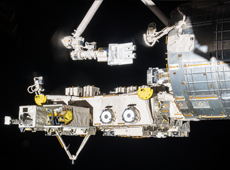 Small satellites being moved from Kibo to space by Kibo’s robotic arm (courtesy of JAXA/NASA)
Small satellites being moved from Kibo to space by Kibo’s robotic arm (courtesy of JAXA/NASA)
Informing potential users about what’s possible is a challenge. For example, one advantage of conducting an experiment on Kibo is the ability to expose a sample to outer space. Something like this is only possible with Kibo. Nonetheless, how many Japanese know about this? Kibo is our property. We would like potential users to know what can be done on Kibo, and want as many people as possible to use it. So we would like to work harder to publicize Kibo.
JAXA has conducted experiments in space since the space shuttle era. My impression is that, ironically, it is this long history that is hindering new ideas and creativity – we have certain stereotypes of what can be studied in space. Many different experiments have been carried out onboard Kibo – so many, you could write a book about them – but today there are still innovative, original ideas out there. For example, Suntory, the brewing and distilling company, is now conducting an experiment with alcohol, studying the process by which spirits become smoother and rounder. This is a good example of a Kibo experiment that we could never have imagined. I am realizing that we have to free ourselves of our preconceptions of what’s possible.
— Are there any requirements for paid Kibo utilization?
We would like Kibo to be used in many different ways, with new ideas, in the hope that this will create a wide range of results. The purpose of these experiments varies, from technology, to education, to companies’ social contribution. Mind you, Kibo is a space lab, so we also want it to be used as much as possible for its original purpose, R&D. And it will be even better if it’s used to solve important problems.
— Finally, could you tell us your vision for the future.
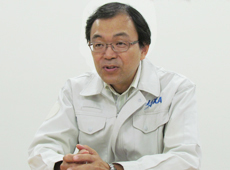
Contributing to Japan’s national technology strategy, enhancing the competitiveness of Japan’s private industry, and acquiring future space technology – in my mind, these three pillars are all equally important. Among the three, the importance of the acquisition of future technology has been in dispute for a while. However, in the future, many countries will be collaborating on new human space exploration missions. I think that, to earn the privilege of participating in the program, Japan will have to bring its own technology to the table. So working on new space technology today will help Japan maintain its presence in the international community in the future. And I believe it’s a core part of JAXA’s mission to make this happen.
In the meantime, for people to be able to appreciate the value of Kibo, it has to be used more extensively, and it is important to achieve results that are beneficial to both the public and private sectors. We already have a lab in space, yet we are short of ideas for making good use of it. This is a challenge. With new ideas, I believe that Kibo can benefit more people. It would be wonderful if, for example, while travelling on the train, people could imagine what would happen if there were no gravity. Gravity is something we take for granted in everyday life, but if you pay closer attention to it, you may get new ideas. For the next phase of Kibo, I would like to create an environment in which such inspiration can be fully exploited.
Tetsuya Sakashita

Manager, Kibo Promotion Office, JEM Utilization Center, Human Spaceflight Technology Directorate, JAXA
Mr. Sakashita received his master’s degree from the School of Engineering at Tohoku University In 1990, and joined NASDA (now JAXA). He has been engaged in the development of the International Space Station, the Japanese Experiment Module Kibo, the Centrifuge Accommodation Module, and the H-II Transfer Vehicle KOUNOTORI. After working in Public Affairs, he was appointed to his current position in 2014. He is in charge of the promotion of Kibo utilization.
[ April 13, 2016 ]